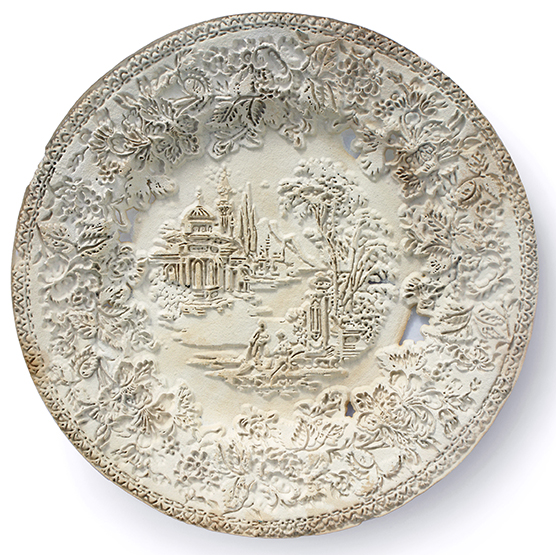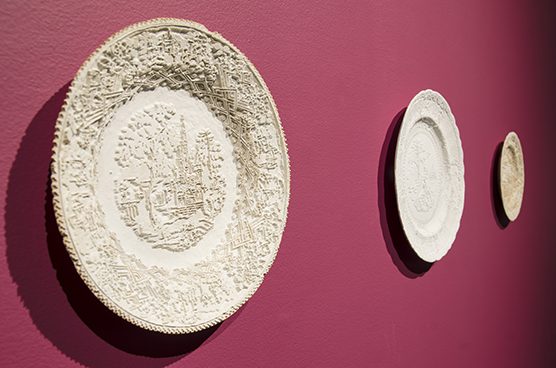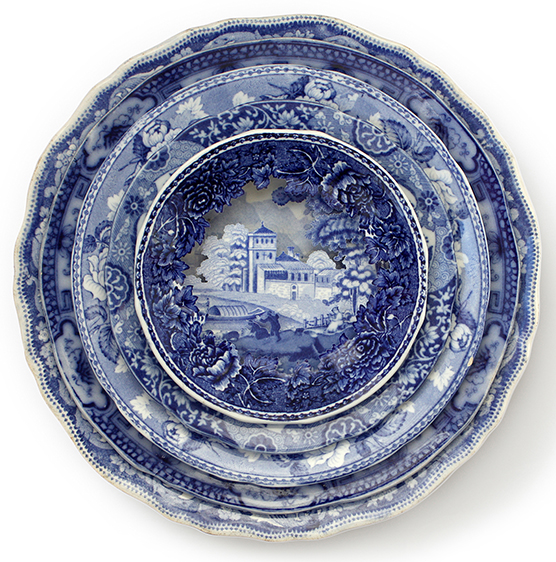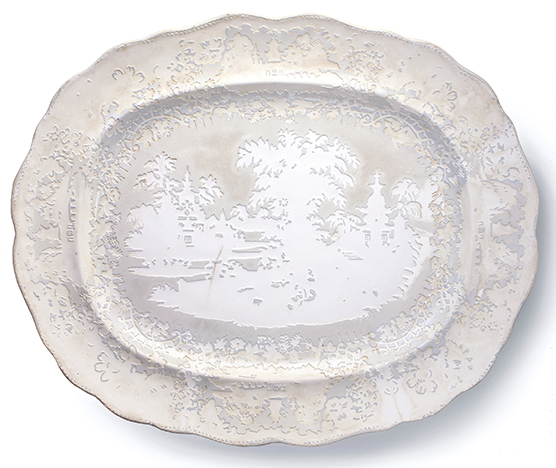
Caroline Slotte, plate from the “Tracing” series, 2015. Reworked second-hand ceramics. Photo by Caroline Slotte.
As part of the social media campaign “Can You Name Five Women Artists?” this blog entry celebrates a female artist whose work is on view in our galleries. Houston Center for Contemporary Craft (HCCC) joined The National Museum of Women in the Arts along with several other institutions around the country to celebrate female artists for Women’s History Month. To read other articles in our series of #5womenartists, click here.
This week, HCCC’s Curatorial Fellow Sarah Darro asked At Your Service artist, Caroline Slotte, a few questions about the processes and inspiration behind her work.
Sarah Darro: Memories are formed and cemented, reinforcing neural pathways in our brains through repetition. Likewise, through recurring strokes, your Tracing Series transforms the decorative patterns of antique plates into intricate three-dimensional reliefs. Could you explain your process and how it relates to this physiological occurrence in the brain?
Caroline Slotte: A recurring theme in my work concerns the interpretation of visual information – how for instance a detail that is difficult to read, a bearer of information that can only barely be decoded, has the capacity to attract the gaze and captivate attention. I frequently employ techniques of reduction and removal and have often been surprised by how little visual information that is needed in order to suggest a connection or a pictorial reference. The risk of a work becoming over-explicit in its expression is far greater than the risk of visual allusions being too subtle.
In my work, I try out various physical manipulations of the objects. This is a method in which periods of concrete experimentation is followed by careful observation, repeated considerations, small adjustments, then more observation, and so on. I am usually, if not always, dependent on having a visual result to relate to. Before I have that, I know nothing whatsoever about the quality of the idea I am working on. I simply have to see the result in order to evaluate it – or even to know what the work is about, what it says.
In Tracing Series, I used a process of repeated masking and sandblasting to remove the glaze and the printed imagery step-by-step. When sandblasting the sand eats away on everything hard. Anything soft and flexible, such as the glue I use for masking, remains, the sand cannot penetrate it. I work my way down, layer by layer, rendering the motif three-dimensional, until the image is transformed into something resembling an imprint or an X-ray, as though a memory of the image had sunk into the plate.

SD: In At Your Service, each of your plates has a distinct landscape and china pattern characteristic of where they were produced. What is the significance of place in your work? What makes you choose a particular plate?
CS: The poetry of everyday things, borne by the memories and stories of these objects – that is the theme on which my artistic practice centers. When choosing materials, I usually work with a pre-determined processing strategy at the back of my mind. The strategy is often formulated as a quite specific instruction to myself, for instance: “Remove everything blue from the plate.”
When it comes to the category of landscape-decorated tableware, the paradoxical nature of the imagery fascinates me. Looking closely at objects such as these you soon discover how intertwined our cultural history is. This context is relevant in that it provides a certain fullness, a richness of information around the objects. However, I rarely highlight the historical background of the objects as part of the contents of my works. Instead, I often zoom in on associations and stories grounded in the directly-experienced everyday life, situations and events that rarely concern the object’s more general cultural and historical background. In my processing, I strive increasingly to achieve transformations that do not favor one particular reading, but which facilitate multiple associations, multiple narratives. I want to make way for an interpretative openness, so that the frame through which the objects are normally viewed is changed or expanded.

SD: Do you have a female role model that has inspired you and your career? If you do, how has this person influenced your life?
CS: It has only recently dawned on me how much my two sisters have influenced me. Growing up, you unconsciously mirror yourself in your siblings, and having to measure up to two exceptionally independent, talented and hard-working sisters has pushed me to set my standards high. Both of my sisters are today successful researchers within their respective fields of natural science and the humanities. I admire their persistence and feel reassured by the example they set when it comes to pursuing professional ambitions.

Caroline Slotte’s plate from the series “Going Blank Again,” 2016. Reworked second-hand ceramics. Photo by Caroline Slotte.
About Caroline Slotte
Caroline Slotte lives and works in Helsinki, Finland. She holds an MA in Ceramics from Bergen Academy of Art and Design in Norway and a BA in Ceramics & Glass from Designskolen Kolding in Denmark. From 2007 to 2011, Slotte was a research fellow in the Norwegian Artistic Research Fellowship Programme. Affiliated with Bergen Academy of Art and Design’s Departiment of Specialized Art, she was also a member of the interdisciplinary research project Creating Artistic Value, funded by the Research Council of Norway. Slotte´s works have been exhibited internationally and are in the permanent collections of the Museum of Arts and Design (New York), the Victoria & Albert Museum (London), Röhsska Museum (Gothenburg), the Museum of Decorative Arts (Oslo) and the Design Museum (Helsinki), among others.
The reworking of second hand objects plays a pivotal role in Caroline Slotte’s practice. She manipulates found materials, primarily ceramic everyday items, so that they take on new meanings. Demonstrating an engaged sensitivity towards the associations, memories and narratives inherent in the objects, her intricate physical interventions allow us to see things we would otherwise not have seen. For more information about Caroline Slotte, please visit, https://carolineslotte.com/.
Caroline Slotte’s Tracing Series is featured in At Your Service, on view in the Main Gallery at Houston Center for Contemporary Craft, February 5 – May 8, 2016.

